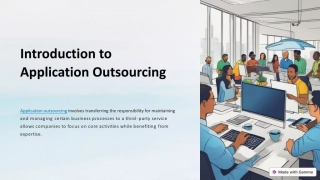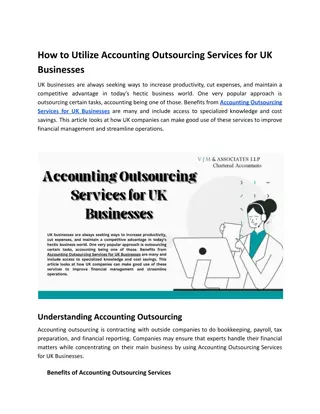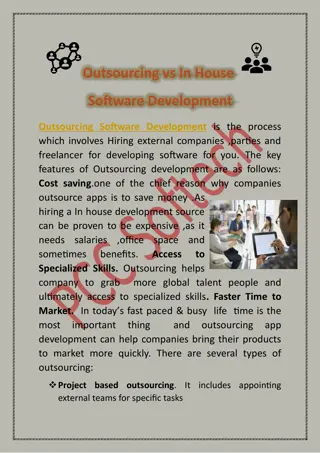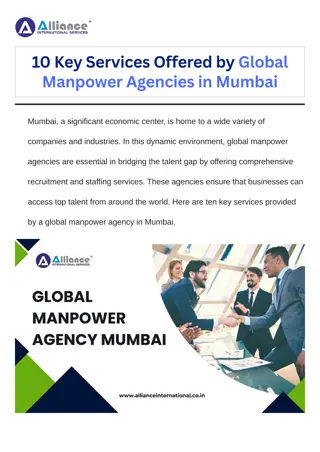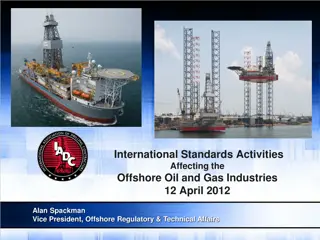Challenges and Opportunities in Offshore Outsourcing for IT Organizations
Proliferating technology and innovation have led to a notable trend in IT outsourcing. However, offshore outsourcing poses unique challenges like communication issues, cultural differences, and time zone constraints. Organizations must carefully assess the efficiency and capabilities of offshore outsourcing teams to mitigate risks and maximize benefits.
Download Presentation

Please find below an Image/Link to download the presentation.
The content on the website is provided AS IS for your information and personal use only. It may not be sold, licensed, or shared on other websites without obtaining consent from the author.If you encounter any issues during the download, it is possible that the publisher has removed the file from their server.
You are allowed to download the files provided on this website for personal or commercial use, subject to the condition that they are used lawfully. All files are the property of their respective owners.
The content on the website is provided AS IS for your information and personal use only. It may not be sold, licensed, or shared on other websites without obtaining consent from the author.
E N D
Presentation Transcript
KEY TO SUCCESS OF OFFSHORE OUTSOURCING Final Thesis Instructor : Dr.Thomas Sheives Prepared by Deep Patel
OUTSOURCING What is Outsourcing ? Transfer business process from inside org to outside org. What is Offshore outsourcing? Cross border transfer of business process to a provided located outside a firm s home country Types?
COUNTRIES 95% OF OUTSOURCING Russia Canada Europe Israel China Japan Mexico Philippines India Singapore Brazil Australia
REASONFOROUTSOURCING Saving on overhead and labor costs, reduced cost Improve quality Conserve capital Foster innovation Increase speed to production(market) Improved efficiency, greater productivity and the opportunity to focus on core products and functions of the project management
ABSTRACT With the proliferating growth in technology and Innovation and the necessity to use new technology skills, outsourcing has become a notable trend in the IT industry. However, amidst the entire buzz, outsourcing has contributed to some major failures at recent times . That has even made organizations to critically think before going forward with an off-shore outsourcing company/ Software Development outsourcing encompasses a contract based voluntary relationship between vendors and clients. However, an offshore outsourcing demands completely different capabilities as against a domestic outsourcing. To begin with, firms associating with off-shore outsourcing must need to compete against language constraints, cultural differences, contrasts in time zones and also the organizational structures. Such disadvantages in outsourcing can be a high limiting factor to the growth of these offshore outsourcing, hence organization must need to understand the level of efficiency of an off-shore outsourcing team before relying on them
PROBLEMWITHOUTSOURCING Communication issues Clash in Time- Zones Cultural differences Instructions follow Uncertain political climate Infrastructure issues Meeting Deadlines Confidentiality and Security issues
LITERATURE REVIEW Prevalent challenges for company : Confusions and ambiguities owing to a geopolitical environment Irrelevance in the organizational and national values, norms, and cultures. Securing the intellectual capital and the proprietary based information In-accurate background knowledge on the off-shore vendors Impractical anticipations for lowering expenses Multiplicities in Time-Zones in various global based locations Client Collocation that is activity based and team members of global vendors Transfer of knowledge between the client and the vendor based team members Layoffs and human capital loss Constraints in workflow for end users.
METHODOLOGY The nature of the research has been conducted as an exploratory approach and is based on a specific case study regarding the development of software. The organization whose case shall be studied here deals in services related to computer support as well as manufacturing and has been discerned in the level of SW-CMM. It has units of software development for demand of internal clients across world-wide. The headquarters are situated in US. The collection of data had been done using primary sources via interviews and secondary sources via the document reviews as well as the process of software development. Understanding the respondents, there was an interview done with 11 people who represent from Brazil and resemble two significant projects. The development of the case study encased the development unit of software situated in Porto Alegre which is in southern Brazil. The aim of the center focuses on performing a global development of the technology regarding the organization.
CASESTUDYANALYSIS/FINDING Technical impact: used waterfall model to identify the issue. Business impact : interviews had been conducted on individuals had mentioned as project s distribution is made on several sites, there is a need of having an comprehensive requirement series as much as possible. The problems related to language and communication had been encouraged by the differences in culture in between the sites and the dispersed individuals. Ultimately the factor of trust was an issue, most significantly the need of a dissemination acquisition of trust. Project management impact: A project management is key to successful execution of a project. the impact of the determinants of project management like the Time management, cost management as well as quality management factors must be monitored more stringently to ensure the successful execution of the project
TECHNICALIMPACT Lack of the use of requirements of the Waterfall model Analysis Design Coding/Development Testing Operations
BUSINESSIMPACT Communication issues Clash in Time-Zones Cultural contrasts Meeting Deadlines
PROJECTMANAGEMENTIMPACT Cost Time management Quality management
DISCUSSION Phase of application development Category of outsourcing Issues Control Responsibilities Trust Coordinating with vendor
THEDECISIONTOOUTSOURCE Outsourcing offers new opportunities. A structural approach will take into account different factors which influence outsourcing. Situation of the organization The drive Issue of outsourcing Final decision
THINGSNEEDTOBECONSIDERBEFOREOFFSHORE OUTSOURCING Cultural cost Documenting requirements Negotiating contracts, legal fees Quality assurance testing Cost of managing contract offshore Security and privacy Political issues Skills and expertise aptitude match project Country stability Certification
FUTUREPROSPECTOFFSHOREOUTSOURCING There is no denying to the fact that outsourcing brings new challenges and opens the door to a new wider business world, though some more time is required to solve the problem of paradigms, risk, designs, boundaries, specifications, designs. Organizations need to develop models for successful outsourcing because this process of outsourcing is very complex. Organization s situation, status, the main drivers to outsourcing should be addressed to before taking any decision. A software development outsourcing framework should be developed to progress outsourcing decisions in a systematic. If everything is planned properly it will improve the quality of the good, it will be delivered timely and also at a much reduced price and will provide time to organizations to focus on core business.
RISK ANALYSIS & RISKMANAGEMENT A risk analysis provides a real time analysis of risks. And it is generally followed prior to the selection of the vendor. However, in our case, the issues and difficulties faced has created a significant to re-build our assessment methodologies. The risk analysis filters the probable risks that the outsourcing s association with the company may deliver. Risk management is a continuous process that comprises of both components: vendor and contract management, the SLA or service level agreement Vendor and contract management monitors the historical or the statistical performance of the outsourcing relationship. The SLA shall entail the statistics that meets the requirements for the involved parties. The SLA requires a periodic assessment and regular updating according to the terms of the contract
PROBLEMEXISTENCE - Offshore outsourcing has many stringent challenges some of which might be inevitable to control. Despite solutions being found and actions were taken, the prevailing issues in outsourcing continue to remain. - With the issues like communication problems, meeting deadlines and following instructions concerned, it is to be seen whether or not the issues are solved efficiently
PROPOSEDSOLUTIONAPPROACH Engaging with the team Emphasizing the review Generating actions for improvement Countering communication issues Countering instruction following issues Countering issues of deadlines Countering cultural differences Countering time-Zone differences
CRITICALSUCCESSFACTOR Supportive culture: Team effort, strong work morals and can do attitude. Endurance: achievement takes time(long run vision). Pre-plan: Resources need to be select and allocated early as per the project requirement. Responsibility: Well experienced, skilled, mature staff must be utilized in a timely fashion. Clarity: Roles must be lucid with responsibilities and expectations defined in detail to each resources. Outside the box: must need to think about advantages beyond cost savings.
CONCLUSION It is not simple math when making decision to offshore outsource a company s IT function. Considering all the risks associated with going offshore is just as necessary as considering the rewards. Off-shore consulting is myriad and unique, the most stringent. off-shore outsourcing constraints resemble to be Cultural and Language barriers from the case study. With different professional environments, the penetration of the culture and traditions make the process of working with an offshore client more complex. Along with other issues like clash in time-zones, lack of a fast responsiveness.
REFERENCE. 1. Ranganathan, C., Balaji, S. (2007). "Critical Capabilities for Offshore Outsourcing of Information Systems," Indiana University, USA. Sprouts: Working Papers on Information Systems, 7(14). http://sprouts.aisnet.org/7-14. 2. Khan, Siffat Ullah, Mahmood Niazi, and Rashid Ahmad. "Barriers in the selection of offshore software development outsourcing vendors: An exploratory study using a systematic literature review." Information and Software Technology 53.7 (2011): 693- 706. 3. Siffat Ullah, Mahmood Niazi, and Rashid Ahmad. "Factors influencing clients in the selection of offshore software outsourcing vendors: An exploratory study using a systematic literature review." Journal of systems and software 84.4 (2011): 686-699. 4. Khan, S., Niaz, M., & Ahmad, R. (2011). Barriers in the selection of offshore software development outsourcing vendors: An exploratory study using a systematic literature review. Information And Software Technology. http://dx.doi.org/10.1016/j.infsof.2010.08.003 5. Penrose, J. (1976). A Survey of the Perceived Importance of Business Communication and Other Business-Related Abilities. Journal Of Business Communication, 13(2), 17-24. http://dx.doi.org/10.1177/002194367601300203
6. Critical Capabilities for Offshore Outsourcing of Information Systems. (2007). Association For Information Systems AIS Electronic Library (Aisel). Retrieved from http://aisel.aisnet.org/sprouts_all 7. Gurung, A. & Prater, E. (2006). A Research Framework for the Impact of Cultural Differences on IT Outsourcing. Journal of Global Information Technology Management, 9(1), 24-43. http://dx.doi.org/10.1080/1097198x.2006.10856413 8. A, G. & M, A. (2016). Values and Disadvantages of Outsourcing the Regulatory Affairs Tasks in the Pharmaceutical Industry in EU Countries. Pharmaceutical Regulatory Affairs: Open Access, 05(01). http://dx.doi.org/10.4172/2167-7689.1000161 9. Yang, B., Yuan, N., & Liu, M. (2014). The impact of boundary spanning capability, cultural differences on a success of offshore information system outsourcing - from the vendors' perspective. IJNVO, 14(1/2), 4. http://dx.doi.org/10.1504/ijnvo.2014.065086 10. Wallenburg, C., Cahill, D., Michael Knemeyer, A., & Goldsby, T. (2011). Commitment and Trust as Drivers of Loyalty in Logistics Outsourcing Relationships: Cultural Differences Between the United States and Germany. Journal Of Business Logistics, 32(1), 83-98. http://dx.doi.org/10.1111/j.2158-1592.2011.01008.x


